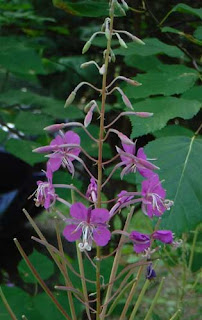Monday morning was calm; there was not a ripple on the lake.
 |
| Absolute calm Monday morning |
We had blueberry pancakes with peaches and bacon for
breakfast.
 |
| Breakfast |
I’d seen fireweed blooming on previous visits. It belongs in
the mustard family, and I assumed from the long, slender pods that its seeds
were small, round, and mustard like.
 |
| Fireweed blossoms and long seed pods |
I was wrong. The seeds are tiny and wind dispersed by long
plumes. Interestingly, this plant growing in front of our cabin was the only
one that had matured to the point of dispersal, and we saw hundreds of fireweed
plants along the roadsides.
 |
| Pods splitting to release wind-dispersed seeds |
 |
| Close up of tiny seeds and large plumes |
When we were at the Visitors Center in Grand Marais
Saturday, we picked up a passport-sized brochure called Passport to the Past. It
featured a number of historical locations that we had never visited. We started
with a visit to Maple Hill, which was founded in 1891 by John and Peter Rindahl,
immigrant brothers from Scandinavia. Maple Hill? In the land of birch and
conifers?
The first surprise was that there were maples on Maple Hill.
In fact, once I started looking for them, I saw maples everywhere.
We found the Maple Hill church, which seemed to still be in
use. A Weber grill was outside the front door. It’s behind the tree in this picture.
 |
| Maple Hill church--the tree on the left hides a Weber grill next to the sidewalk |
I walked around the adjacent cemetery, looking at
gravestones. The Passport to the Past said that “memories of the early years
were of hardship and near starvation.” If the soil in the cemetery was typical
of the area, farming would have been a difficult pursuit. I wondered if they
dug graves with a jackhammer. This grave, from last February, shows the rocky
soil with not a single plant growing. A grave from 2017 was only sparsely
covered with grass.
 |
| A grave from February has no plant growth on it |
Whenever I walk through a cemetery, I wonder what stories
are lying underground. M. Jane Burley had an interesting life. Her headstone
suggests that she was a scientist, artist, and musician. “A chosen life well
lived” for 96 years. An inspiration to us all.
This is the headstone of John Rindahl. I had more questions
about this one than answers. If 1891 is in fact a birth date, he may have been
the son of John Rindahl, founder of Maple Hill, which would mean that John
Rindahl had a wife either when he came or soon after he arrived. Or maybe it is
the grave of the original founder, and the first date is when he came to Maple
Hill. If so, he was either crazy or just unfortunate to start a life in a new
land at the beginning of winter.
 |
| Grave of John Rindahl |
There are the markers of sadness and tragedy as well. The
first graves in the Anderson plot were not the expected Grandmother and
Grandfather, but Grandmother and Grandson. Grandmother may have been one of the first
residents.
 |
| The graves of Grandmother and Grandson |
Here’s another one for an infant who died in 1918, the same
year as the Spanish flu pandemic.
 |
| Possible infant mortality from Spanish flu |
I liked the loons on this stone.
 |
| Loons on the headstone |
Did this young man die in combat? I’ll never know. “Forever
smiling in our hearts.” SpongeBob in the Pattymobile is on the right, an unopened
can of Bud Light is on the left. There’s a story there.
 |
| Veteran's grave decorated with Bud Light and SpongeBob |
Whether this tree was planted or began as a seed, this
little spruce growing in the stump of a dead tree is a reminder of the cycle of
life.
 |
| Life from death--a spruce grows in the stump of a dead tree |
After these reminders of our own mortality, we went to
Sydney’s in Grand Marais for custard before returning to the cabin. As the
saying goes---life is short; eat dessert first.
We had lemon chicken with garlic, green beans from my
garden, and fried leftover baked potatoes for supper.
 |
| Lemon-garlic chicken, green beans, and fried potatoes |
No comments:
Post a Comment